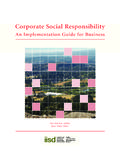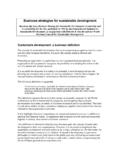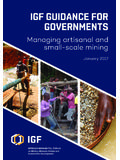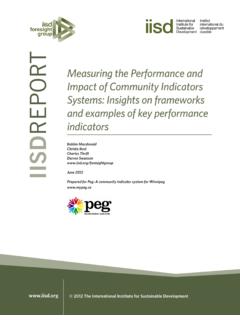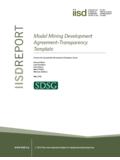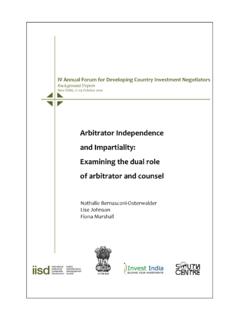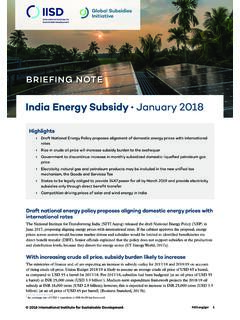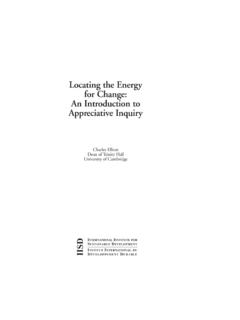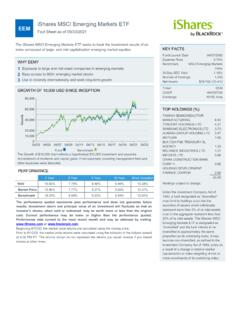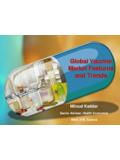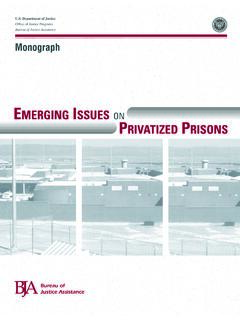Transcription of Global Market Report: Coffee - International Institute for ...
1 Demand for Coffee is expected to grow, but low farm profitability may hurt is one of the most traded agricultural commodities in the world: in 2017 alone, 70 per cent of total Coffee production was exported, worth USD 19 ,2 That same year, the sector had a retail Market value of USD 83 billion, providing jobs for 125 million ,3 Coffee is grown on million farms worldwide, of which 67 80 per cent are smallholder farms primarily located in developing countries, including 22 Low Human Development Countries (LHDCs).4,5 The largest producing and exporting countries in 2017, irrespective of human development level, were Brazil (USD billion), Vietnam (USD billion) and Colombia (USD billion), while the largest importing countries in 2017 were the United States (USD billion), Germany (USD billion) and France (USD billion).6 Overall, Coffee supply growth outpaced demand growth from 2016 to 2017, at rates of 5 per cent versus 2 per cent respectively, resulting in a Global Coffee surplus of around 250,000 metric tonnes.
2 The Global supply demand balance of Coffee varies from year to year: 2016 closed with a supply deficit, while a surplus is estimated for The sector is projected to grow, fuelled by increasing demand from producing countries and emerging economies that have not traditionally been among the major Coffee importers, such as Brazil, Indonesia and China, as well as the expansion of retail options and Coffee -based products such as ready-to-drink ,8 Another notable development is the increased adoption of voluntary sustainability standards (VSSs) by Coffee producers: in 2016, per cent of the Market was made up of VSS-compliant Coffee , while Coffee that was potentially VSS-compliant represented per cent, and conventional Coffee production accounted for 44 per cent of the Coffee Accounted for at Least 34 Per Cent of Total Coffee Production in 2016 Figure 1. Global Coffee production trend 2008 20169 Note: Conventional production volumes do not comply with a VSS, while VSS-compliant production volumes refer to Coffee produced in compliance with one or more VSSs.
3 Production volumes that are defined as potentially VSS-compliant cannot be definitively identified as conventional or VSS-compliant with the data currently CompliantPotentiallyVSS CompliantConventional02,000,0004,000,000 6,000,0008,000,00010,000, TonnesGlobal Market Report: CoffeeSUSTAINABLE COMMODITIES MARKETPLACE SERIES 2019 Vivek Voora, Steffany Berm dez, Cristina Larrea, Sofia Bali o Series Editor: Sofia Bali oHow Much Coffee is Certified by Each Standard?Figure 2. Standard-compliant Coffee production volumes in 20169 Consumption of more sustainable Coffee supports the growth of VSS-compliant production, which can help address environmental and social development challenges. VSSs emerged in the Coffee sector over 30 years ago, with non-governmental organizations, private sector actors and other industry stakeholders looking to provide roasters, retailers and consumers with the ability to distinguish between conventionally produced Coffee and its more sustainable Coffee equivalent.
4 The latter options would be produced in a way that was conscious of emissions, biodiversity conservation, and worker health and safety considerations throughout the value chain, while also aiming to provide larger economic gains for producers. Being able to associate a particular Coffee brand with a socially and environmentally sound reputation through certification was meant to stimulate demand from Coffee sourcing companies and end consumers for this type of product. This would in turn drive greater investment into more sustainable production practices, and the corresponding training and support that farmers would need to change their production techniques and approaches, thus boosting the supply of VSS-compliant date, there are some promising signs of VSSs success on the supply side, particularly in recent years: VSS-compliant Coffee experienced a CAGR of about 24 per cent from 2008 to 2016, accounting for at least 34 per cent of Coffee production overall.
5 4C, UTZ Certified, Rainforest Alliance, Fairtrade and Organic are the main VSSs in the Coffee sector, when ranked by production size. In 2016, at least 3 million metric tonnes were VSS-compliant, with Coffee valued at USD billion. This value is derived from the average producer prices per country, as reported by the Food and Agriculture Organization of the United Nations (FAO), which is then applied to the volume of VSS-compliant Coffee produced per ,10 The majority of VSS-compliant production, at approximately 70 per cent, comes from Latin America (Brazil, Colombia and Peru) with some important volumes coming from Asia (Vietnam and Indonesia) and Africa (Ethiopia, Tanzania and Uganda).9,11 The Market advisory firm Mordor Intelligence predicts that the Global Market (retail) value of the Coffee sector will experience a per cent compound annual growth rate (CAGR)
6 From 2018 to 2023, yet this positive outlook must be viewed against the Coffee sector s history of price volatility across multiple decades and long-term price Traditionally, farm gate prices have struggled to keep pace with production costs, which hurts farm profitability and makes it difficult for Coffee farmers to make long-term decisions on investments and planting, ultimately disincentivizing many of them from staying in the ,7 Increasing the volume of Coffee production, regardless of whether this Coffee is VSS-compliant, to meet the projected growth in demand from non-traditional Coffee importers is further challenged by the effects of a changing climate, as land suitable for Coffee cultivation will be subject to more unpredictable weather patterns, with negative implications for Coffee yields. These climate change risks are not limited just to extreme weather events: there are already cases where Coffee -producing countries have faced severe pest and disease outbreaks, such as Coffee rust, that have decimated their crops and further exacerbated the volatility of the Global Coffee ,764,002 MTUTZ Certified870,102 MTFairtrade International560,902 MTRainforest Alliance508,632 MTOrganic431,912 MTLIVELIHOODSOver 125 million jobs in the Coffee million growing farms 67%-80% smallholder farmsOn the demand side, the results have been mixed.
7 The 10 largest Coffee roasting companies purchased million metric tonnes of Coffee in 2016, accounting for 35 per cent of total Global Coffee sourcing. From this total, million metric tonnes were VSS- and corporate-initiative-compliant Coffee , which refers to sustainable Coffee production programs established by private companies rather than by independent third Examples of corporate sustainability initiatives in the Coffee sector include Starbucks CAF Practices and Nestle s Nespresso AAA programs. Based on the sourcing commitments of the 10 largest Coffee roasting companies, and assessing these against current Coffee sourcing information, an additional million metric tonnes of sustainable Coffee could be sourced by 2025. The leading buyers sourcing commitments are driven mainly by final end consumer preferences to purchase more sustainable and healthy Even though demand for VSS-compliant Coffee continues to grow, because this demand is concentrated mainly in traditional markets such as Europe and the United States, it remains lower than This supply demand imbalance can limit VSS-compliant Coffee s Market growth potential and needs to be addressed by value chain actors to benefit from the opportunities that stem from growing Coffee demand from non-traditional Coffee importers.
8 This includes higher demand from producing countries and emerging economies, especially those in Asia and ,7,8 Expanding production of sustainable Coffee may require moving into less-developed growing Coffee and sustainable corporate initiatives are propelling the sector toward potentially becoming one of the first commodities to reach significantly high compliance with a sustainability initiative. This potential, however, must be assessed against the above-mentioned risks, such as price volatility and price decline, oversupply of VSS-compliant Coffee and the effects of climate change on Coffee Sustainable Consumption (MT, 2016)Conventional Consumption (MT, 2016)Sustainable Sourcing Commitment (% and year)* data not found for sustainable sourcing commitments0200,000400,000600,000800,000 1,000,000* Ueshima Coffee Tonnes* Massimo Zanetti Keurig Green Mountain100% sustainable sourcing by 2020 Tchibo100% sustainable sourcing by 2025* LavazzaSmuckers10% sustainable sourcing by 2018 Starbucks100% sustainable sourcing by 2020* StraussNestl 70% sustainable sourcing by 2020* Jacobs Douwe EgbertsCommitment to 70% sustainable sourcing by 2020870,000 MT55% Sustainable Consumption in 201645% Conventional Consumption in 2016In 2016, Nestle's total Coffee consumption was 870,000 metric tonnes, of which 55% was sustainably sourced.
9 They are close to reaching their goal of 70% by ,000710,000350,000290,000285,000200,0001 90,000180,000145,00090,000 Good Progress Toward Sourcing More Sustainable CoffeeFigure 3. Major Coffee roasting companies and their sustainable sourcing commitments4,14 18yields. Although the production of sustainable Coffee is experiencing a greater growth trend than the overall sector, its continued expansion may now require moving into new markets and working with farmers that have fewer resources and less capacity than those that are already VSS-compliant. This strategy will require greater investments and innovative approaches to support farmers as they transition toward more sustainable production Another core consideration in assessing opportunities for expanding VSS compliance in the sector is the human development level of Coffee -producing countries, as assessed by the Human Development Index (HDI).
10 Out of 82 Coffee -growing countries in 2016, 22 were ranked as LHDCs under the HDI, and 11 of these LHDCs produced VSS-compliant Coffee . These LHDCs accounted for 12 per cent of the total Coffee grown in 2016 and were responsible for 8 9 per cent of the total VSS-compliant Coffee produced worldwide that same year. According to our analysis, there have been promising signs of growth in VSS-compliant production among these LHDCs: looking at the 2008 2016 time period, VSS-compliant Coffee production in LHDCs increased at a CAGR of approximately 19 per cent with Organic as the VSS with the largest volume of Coffee production coming from LHDCs followed by 4C and Rainforest Alliance in The expansion of VSS-compliant Coffee production in LHDCs could result in important environmental and societal development benefits via the adoption of more sustainable agricultural practices, such as lower emissions from production and the improvement of working conditions.
